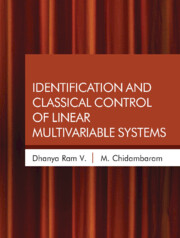Book contents
- Frontmatter
- Contents
- Preface
- Acknowledgements
- List of Abbreviations
- Notations
- 1 Models, Control Theory, and Examples
- 2 Identification and Control of SISO Systems
- 3 Introduction to Linear Multivariable Systems
- 4 CRC Method for Identifying TITO Systems
- 5 CRC Method for Identifying SISO Systems by CSOPTD Models
- 6 CRC Method for Identifying TITO Systems by CSOPTD Models
- 7 Identification of StableMIMO System by Optimization Method
- 8 Identification of Centralized ControlledMultivariable Systems
- 9 Identification of Multivariable SOPTD Models by Optimization Method
- 10 Identification of Unstable TITO Systems by Optimization Technique
- 11 Centralized PI Controllers Based on Steady State Gain Matrix
- 12 SSGM Identification and Control of Unstable Multivariable Systems
- 13 Control of Stable Non-square MIMO Systems
- 14 Control of Unstable Non-square Systems
- 15 Trends in Control ofMultivariable Systems
- Appendix A Identification of Unstable Second Order Transfer Function Model with a Zero by Optimization Method
- Appendix B For Chapter 3
- Appendix C For Chapter 7
- Bibliography
- Index
7 - Identification of StableMIMO System by Optimization Method
Published online by Cambridge University Press: 31 July 2022
- Frontmatter
- Contents
- Preface
- Acknowledgements
- List of Abbreviations
- Notations
- 1 Models, Control Theory, and Examples
- 2 Identification and Control of SISO Systems
- 3 Introduction to Linear Multivariable Systems
- 4 CRC Method for Identifying TITO Systems
- 5 CRC Method for Identifying SISO Systems by CSOPTD Models
- 6 CRC Method for Identifying TITO Systems by CSOPTD Models
- 7 Identification of StableMIMO System by Optimization Method
- 8 Identification of Centralized ControlledMultivariable Systems
- 9 Identification of Multivariable SOPTD Models by Optimization Method
- 10 Identification of Unstable TITO Systems by Optimization Technique
- 11 Centralized PI Controllers Based on Steady State Gain Matrix
- 12 SSGM Identification and Control of Unstable Multivariable Systems
- 13 Control of Stable Non-square MIMO Systems
- 14 Control of Unstable Non-square Systems
- 15 Trends in Control ofMultivariable Systems
- Appendix A Identification of Unstable Second Order Transfer Function Model with a Zero by Optimization Method
- Appendix B For Chapter 3
- Appendix C For Chapter 7
- Bibliography
- Index
Summary
The majority of existing techniques for identification are based on the frequency domain approach. For any optimization method, the selection of initial guess values plays an important role in computational time and convergence. In this chapter, a simple and generalized method for obtaining reasonable initial guess values for the First Order Plus Time delay (FOPTD) transfer function model parameters are discussed. A method to obtain the upper and lower bounds for the parameters to be used in the optimization routine is also presented. The method gives a quick and guaranteed convergence. The standard lsqnonlin routine is used for solving the optimization problem in Matlab. This method is applied to FOPTD and higher order transfer function models of multivariable systems.
Identification of Decentralized Controlled Systems
Identification Method
Consider an n-input and n-output multivariable system. G(s) and GC(s) are process transfer function matrix and decentralized controller matrix with compatible dimensions, expressed in Eq. (7.1) and Eq. (7.2).
The controller parameters can be chosen arbitrarily for the multivariable systems such that the closed loop system is stable with reasonable responses.
Consider a decentralized TITO multivariable system as shown in Fig. 3.2. The process transfer functionmodels are identified by FOPTDmodels.AFOPTDmodel is given in Eq. (7.3).
In this case, a known magnitude of step change is introduced in the set point yr1 with all the remaining set points unchanged and all other loops kept under closed loop operation. From the prescribed step change in the set point yr1, we obtain the main response y11 and interaction response y21. Similarly, the same magnitude of step change is introduced in set point yr2, and we obtain the main response y22 and interaction response y12. The response matrix of the TITO system can be expressed as Eq. (7.4).
The first column in the response matrix in Eq. (7.4) contains the responses (main and interaction) obtained by the step change in the set point yr1 in the first loop. The second column contains the responses (main and interaction) obtained by the step change in set point yr2 in the second loop. From these step responses, the initial guess values of the model parameters are obtained.
In any optimization method, the selection of initial guess values plays a vital role.
- Type
- Chapter
- Information
- Publisher: Cambridge University PressPrint publication year: 2023

